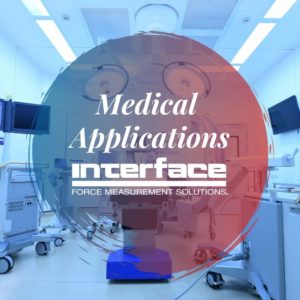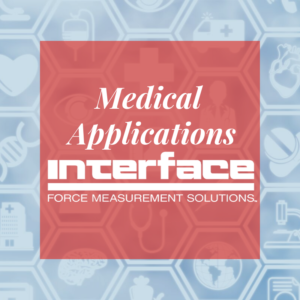Interface Solutions for Medical Devices and Healthcare
 There is a reason that the most highly regulated industries in the world turn to Interface for force measurement equipment used for medical device and healthcare product design, development and testing. The industry must trust the data they are using to optimize or validate product design because the slightest errors can have devastating results.
There is a reason that the most highly regulated industries in the world turn to Interface for force measurement equipment used for medical device and healthcare product design, development and testing. The industry must trust the data they are using to optimize or validate product design because the slightest errors can have devastating results.
In the medical industry, the dependence on accuracy and reliability increases tenfold. Not only are medical devices and healthcare products some of the most complex and delicate technology in the world, the regulations and certification standards they need to meet are stringent. And most importantly, any design flaws or failures could present serious health risks and or worse. Interface has been a trusted partner to medical OEMs and healthcare technology providers around the world for decades.
Our test and measurement products are crucial in the development of numerous medical and healthcare tools, technology, medical devices and equipment used in labs and hospitals alike. Interface has been part of remarkable innovations and test and measurement projects of products implanted inside of the human body and used for prosthetics.
“To serve our customers who need high-quality force and torque measurement testing data, Interface is the provider of choice for accurate, reliable and customizable force measurement products and systems.” Elliot Speidell, Regional Sales at Interface
Engineering and building load cells, along with supplying the best torque transducers, digital instrumentation and accessories all plays a critical role in the evolving needs within the healthcare industry. Interface load cells that can measure capacities as low as 0.11 lbf / 0.5 N have been used to measure the smallest weight change in medical bags. Our multi-axis sensors are used to measure multiple axis of force in the development of prosthetics.
Here are a few applications that showcase different Interface products for healthcare and by medtech OEMs:
VASCULAR CLAMP FORCE
Using an Interface High Speed Data Logging Indicator and Model LBS Load Cell, the customer was able to test multiple clamps, recording the force measurements for each. By using this accurate data, they were able determine the best one to use during surgery. READ THE MEDICAL APP NOTE HERE.
BALL AND SOCKET MED DEVICE
A medical device OEM needed to test a new design for an artificial hip joint. This test needed to validate load consistency, and the durability of their design. Using a 6-Axis Load Cell mounted to the manufacturer’s test machine, they were able to simulate actual use. A Model BX8 was connected to the sensor to collect data. READ THE MEDICAL APP NOTE HERE.
SURGICAL STAPLER FORCE VERIFICATION
A large medical manufacturer required a load button load cell to verify the amount of force needed to activate the surgical stapler. Along with precision measurement, the load cell requirements were it needed to be small, easy to mount, and accurate. Interface’s LBMU Compression Load Button was mounted to the surgical stapler to enable force verification, and then connected to a 9820 Load Cell Indicator to record output. READ THE MEDICAL APP NOTE HERE.
PROSTHETIC FOOT PERFORMANCE
In this use case, Interface supplied products to help our customer test how a prosthetic foot performed during different positions and stances. The products used in this test were the Interface Model 3A120 3-Axis Load Cell, which was installed between the leg socket and the prosthetic foot and the Model 3A120 which was connected to customer’s portable data acquisition system. READ THE MEDICAL APP NOTE HERE.
When standard precision solutions need a custom application, Interface’s solutions team and engineers work directly with medical device manufacturers to deliver specialized products, systems and software that meet evolving needs and innovation.
To provide additional information on the medical customers we serve and the solutions we develop, Interface has created our medical industry case study. The case study provides details on the force measurement needs of the industry, as well as various examples of solutions we have developed for medical devices and equipment from heart medtech devices to some of the machinery used to manufacture medical products.
Click Here to Read the NEW Interface Medical Industry Case Study
You can view some of these medical and healthcare application use cases here.
Contributor: Elliot Speidell, Regional Sales Director at Interface


